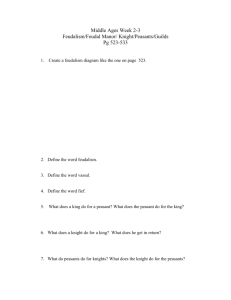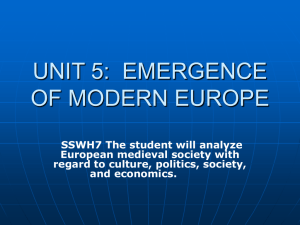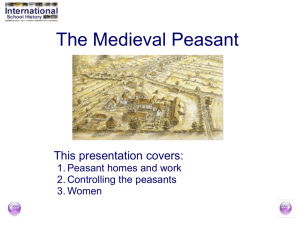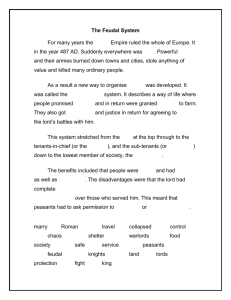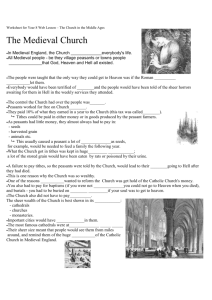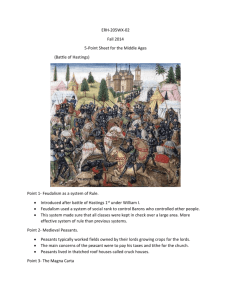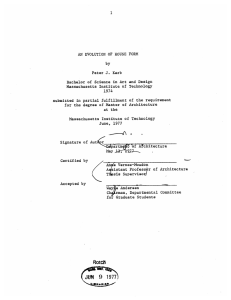File
advertisement
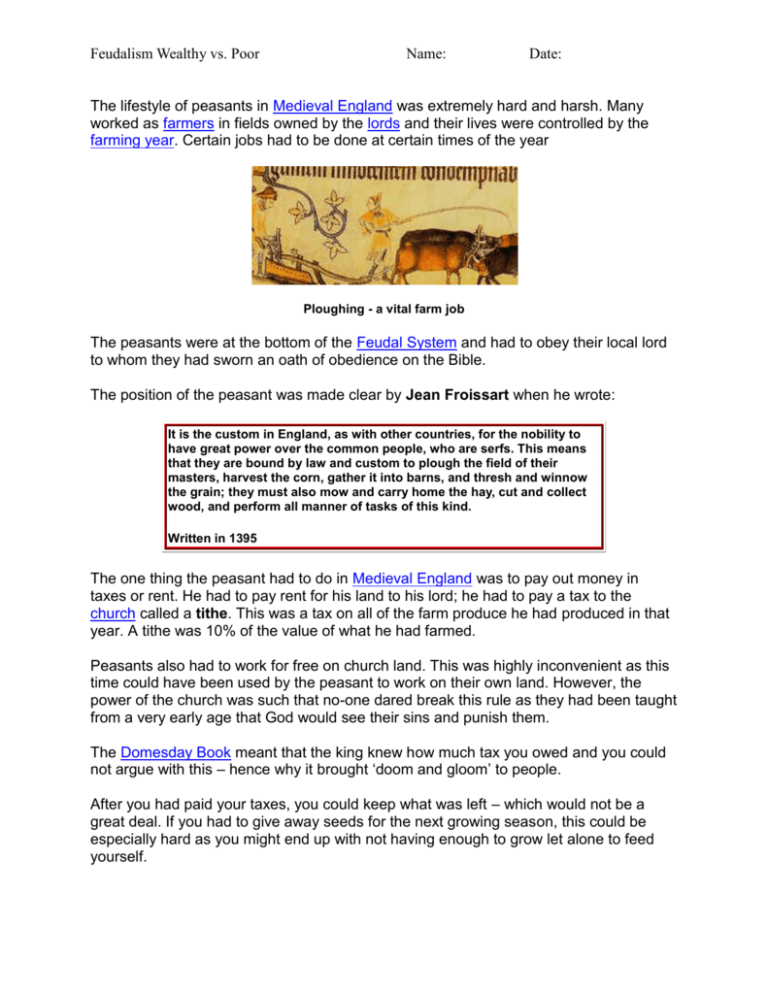
Feudalism Wealthy vs. Poor Name: Date: The lifestyle of peasants in Medieval England was extremely hard and harsh. Many worked as farmers in fields owned by the lords and their lives were controlled by the farming year. Certain jobs had to be done at certain times of the year Ploughing - a vital farm job The peasants were at the bottom of the Feudal System and had to obey their local lord to whom they had sworn an oath of obedience on the Bible. The position of the peasant was made clear by Jean Froissart when he wrote: It is the custom in England, as with other countries, for the nobility to have great power over the common people, who are serfs. This means that they are bound by law and custom to plough the field of their masters, harvest the corn, gather it into barns, and thresh and winnow the grain; they must also mow and carry home the hay, cut and collect wood, and perform all manner of tasks of this kind. Written in 1395 The one thing the peasant had to do in Medieval England was to pay out money in taxes or rent. He had to pay rent for his land to his lord; he had to pay a tax to the church called a tithe. This was a tax on all of the farm produce he had produced in that year. A tithe was 10% of the value of what he had farmed. Peasants also had to work for free on church land. This was highly inconvenient as this time could have been used by the peasant to work on their own land. However, the power of the church was such that no-one dared break this rule as they had been taught from a very early age that God would see their sins and punish them. The Domesday Book meant that the king knew how much tax you owed and you could not argue with this – hence why it brought ‘doom and gloom’ to people. After you had paid your taxes, you could keep what was left – which would not be a great deal. If you had to give away seeds for the next growing season, this could be especially hard as you might end up with not having enough to grow let alone to feed yourself. Feudalism Wealthy vs. Poor Name: Date: Peasants lived in cruck houses. These had a wooden frame onto which was plastered wattle and daub. This was a mixture of mud, straw and manure. The straw added insulation to the wall while the manure was considered good for binding the whole mixture together and giving it strength. The mixture was left to dry in the sun and formed what was a strong building material. What a cruck house may have looked like - minus the wattle and daub Cruck houses were not big but repairs were quite cheap and easy to do. The roofs were thatched. There would be little furniture within the cruck houses and straw would be used for lining the floor. The houses are likely to have been very hot in the summer and very cold in the winter. Windows were just holes in the walls as glass was very expensive. Doors might be covered with a curtain rather than having a door as good wood could be expensive At night, any animal you owned would be brought inside for safety. There were a number of reasons for this. First, wild animals roamed the countryside. England still had wolves and bears in the forests and these could easily have taken a pig, cow or chickens. The loss of any animal could be a disaster but the loss of valuable animals such as an ox would be a calamity. If left outside at night they could also have been stolen or simply have wandered off. If they were inside your house, none of these would happen and they were safe. However, they must have made the house even more dirty than it usually would have been as none of these animals would have been house-trained. They would have also brought in fleas and flies etc. increasing the unhygienic nature of the house. The houses would have had none of the things we accept as normal today – no running water, no toilets, no baths and washing basins. Soap was unheard of and as was shampoo. People would have been covered with dirt, fleas and lice. Beds were simply straw stuffed mattresses and these would have attracted lice, fleas and all types of bugs. Your toilet would have been a bucket which would have been emptied into the nearest river at the start of the day. Feudalism Wealthy vs. Poor Name: Date: Water had a number of purposes for peasants – cooking, washing etc. Unfortunately, the water usually came from the same source. A local river, stream or well provided a village with water but this water source was also used as a way of getting rid of your waste at the start of the day. It was usually the job of a wife to collect water first thing in the morning. Water was collected in wooden buckets. V Towns needed a larger water supply. Water could be brought into a town using a series of ditches; lead pipes could also be used. Bathing was a rarity even for the rich. A rich person might have a bath just several times a year but to make life easier, several people might use the water before it was got rid of! It was said that a peasant could expect to be fully bathed just twice in their life; once, when they were born and when they had died! Face and hand washing was more common but knowledge of hygiene was non-existent. No-one knew that germs could be spread by dirty hands. London had a number of public baths near the River Thames. These were called "stews". Several people at one time would bath in them. However, as people had to take off what clothes they wore, the stews also attracted thieves who would steal what they could when the victims were hardly in a position to run after them! Regardless of how water was acquired, there was a very real potential that it could be contaminated as toilet waste was continuously thrown into rivers which would make its way into a water source somewhere. Families would have cooked and slept in the same room. Children would have slept in a loft if the cruck house was big enough. The lives of peasant children would have been very different to today. They would not have attended school for a start. Very many would have died before they were six months old as disease would have been very common. As soon as was possible, children joined their parents working on the land. They could not do any major physical work but they could clear stones off the land – which might damage farming tools – and they could be used to chase birds away during the time when seeds were sown. Peasant children could only look forward to a life of great hardship. For all peasants, life was "nasty, brutish and short." http://www.historylearningsite.co.uk/medieval_peasants.htm What was life like for a peasant in The Middle Ages (Dark Ages)? Feudalism Wealthy vs. Poor Name: Date: Homes of the Peasants Most medieval homes were cold, damp, and dark. Sometimes it was warmer and lighter outside the home than within its walls. For security purposes, windows, when they were present, were very small openings with wooden shutters that were closed at night or in bad weather. The small size of the windows allowed those inside to see out, but kept outsiders from looking in. Many peasant families ate, slept, and spent time together in very small quarters, rarely more than one or two rooms. Often they shared their home with their livestock, if they had any. The houses had thatched roofs and were easily destroyed. Homes of the Wealthy The homes of the rich were more elaborate than the peasants' homes. Their floors were paved, as opposed to being strewn with rushes and herbs, and sometimes decorated with tiles. Tapestries were hung on the walls, providing not only decoration but also an extra layer of warmth. Fenestral windows, with lattice frames that were covered in a fabric soaked in resin and tallow, allowed in light, kept out drafts, and could be removed in good weather. Only the wealthy could afford panes of glass; sometimes only churches and royal residences had glass windows. Feudalism Wealthy vs. Poor Name: Date: Homes of the Wealthy I. Write the topic Sentence; II. What are the subjects of Comparison? __________________and______________________ III. What are the 3 main differences? ______________,_______________and______________ Block Arrangement (four paragraphs) I. II. Introduction in which you state your purpose: A. B. C. Feudalism Wealthy vs. Poor III. A. B. C. IV. Conclusion Name: Date:

